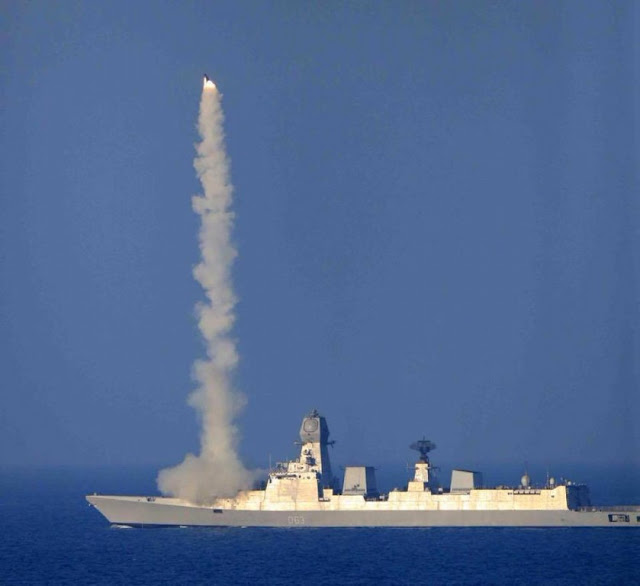The missile arsenal of Indian forces
Cruise Missile
As the name defines these missiles basically cruise to deliver their payload to a designated target. Cruise missiles are usually powered by jet engines, Scramjet and Ramjet are the latest technology. Cruise missiles are very cost effective and the same time can cause havoc our enemy territory. These missiles can fly low hugging to the terrain thus making it extremely difficult to be detected. Cruise missiles are classified based on the speeds, subsonic cruise missiles travel at a speed lesser than the speed of sound approximately at around 0.8 mach ‘Tomahawk and Klub’ are the best examples.
Supersonic missiles travel approximately at around 2-3 mach i.e. almost a kilometre/second of its flight. BrahMos jointly developed by India and Russia is the only versatile Supersonic cruise missile. Cruise missiles enjoy considerable long ranges but owing to the operational cost medium range missiles are favoured by armed forces across the world. Hypersonic missiles are still under development and will fly at around 5-6 mach.
BrahMos cruise missile
India has the worlds fastest and the deadliest cruise missile in its arsenal, BrahMos. India and Russia decided to setup a private company that could work independently off the political circles, the result was BrahMos aerospace a portmanteau of the rivers Brahmaputra and Moskva. BrahMos flies at variable speeds between 2.8-3.0 mach and can be launched from all platforms.
The ‘missile man’ of India APJ Abdul Kalam and the then Russian deputy defense minister N V Mikhailov worked relentlessly get BrahMos going. The project took baby steps with India holding 50.5 % share and Russia holding 49.5% share in a joint venture. Russian government and Indian government pitched in US $123 and US $127 million respectively for the project. After three long years of hard work, BrahMos was for the first time test fired from ITR, Chandipur on 12th June 2001.
Repeated tests followed and the missiles was tested for VTL, mobile launcher and land attack capabilities during the course of 10 years. The development and success with BrahMos has been a never ending process, the missile has evolved over the years and is now currently in Block III configuration. Till date 35 validation and trail tests have been carried out, during one such test BrahMos became the world’s fastest cruise missile.
On 20th March 2013, the submarine launched version of BrahMos was testes fired from a submerged pontoon of the Visakhapatnam coast. BrahMos-A the air launched version is expected to be test fired shortly from a IAF Su-30. Indian navy and Indian army have already deployed the BrahMos. Air force has also placed an order for over 200 air launched version of the BrahMos.
Nirbhay cruise missiles
The home grown Nirbhay, is a multi-platform all weather cruise missile. The missile can carry one tonne of payload and has operational range of 1000 km. Nirbhay is a two-stage missile system with loitering capability. Nirbhay is equipped with ring-laser gyroscope for accurate strikes. Nirbhay can fly at extremely low altitudes, the missile is enabled with terrain hugging technology which effectively means the missile can fly in the tree levels. This method is instrumental in avoiding detection by enemy radar systems and can help in reducing the reaction time of the enemies.
Nirbhay is capable of carrying both nuclear and conventional warheads. Initially Nirbhay will be launched from a mobile launcher which has been developed by Tata. Further development will guarantee the launch of Nirbhay from Aerial and Naval platforms. The missile will supplement the BrahMos with its extended range.
The first test of the missile took place in February 2013, the test was a partial success as the missile was destroyed half way to its target after it showed diversion in its trajectory. The missile was again tested in October 2014, the missile delivered the package to the designated target flying flawlessly through the skies. Nirbhay is expected to enter service in less than three years. India also has the Exocet and Harpoon missiles in its arsenal.
Ballistic Missile
A ballistic missile is a missile system that follows a ballistic trajectory over most of its flight path where most of its trajectory is governed by the gravitational pull of earth. Ballistic missiles cover most of their flight in the stratosphere and during the terminal phases enter the atmosphere and are guided to a per-designated targeted with the help of highly advanced navigational systems. Ballistic missiles are usually powered by multi-stage rockets and are usually classified based on the range and the payload they can carry i.e. conventional and nuclear warheads.
Ballistic missiles can be launched from silos situated either on the ground or in submarines which is the best platform for retaliatory strikes. Ballistic missiles launched from the submarines are classified as SLBM (Submarine Launched Ballistic missile). India has a very matured ballistic missile program thanks to the relentless work of DRDO. The Agni program serves as the umbrella program for India’s ballistic missile program.
Agni V remains to be the most advanced ballistic missile, India has developed. Agni V has a confirmed range of 5500 km classifying it as an ICBM (Inter-Continental Ballistic Missile). K-missile family are SLBM’s, K-4 which is currently under development will have an operational range of 3500+ km. The K-12 with 750 km has been fitted out on INS Arihant and is slated to be test fired in the near future.
Article by - Karthik Kakoor




No comments:
Post a Comment